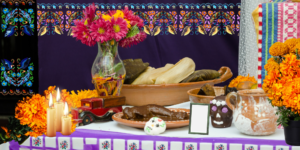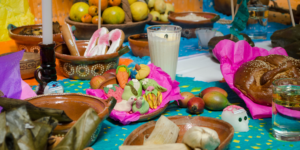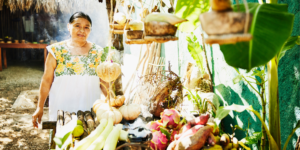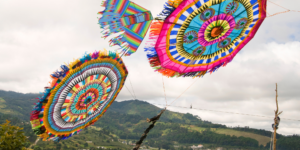
U NÁAJIL A PIXÁN / THE HOUSE OF YOUR SOUL
To t?aane? u náajil to pixán / Your language is the house of your soul.
Tumen you? kuxa?an a laats?ilo?ob / Your parents and grandparents live there.
Ti?e? úuchben xa?anilnaj / In that ancient house,
uk?aasal to kajtalil / home of your memories,
you? ku p?aatal at?aan / your word remains.
Le béetike? / That's why,
ma? wóok?tik u kíimil a wínklil / do not cry the death of your body,
mix a wóok?tik u kíimil a pixán / nor mourn the death of your soul;
to wíinklil / your body,
máantats ku p?aatal ichil u yich a páalal / remains in the faces of your children;
to pixané / your soul,
máantats ku léembak ich u yich xuxil éek?ob / eternalizes in the brilliance of the stars.
-Jorge Miguel Cocom Pech, Mayan Poet
For the Mayans, death was not the end of life, but the beginning of a new stage; and with colors, smells, flavors and textures, this ancient culture celebrates Hanal Pixán (food for the souls), a celebration of its dead who return every year to visit their loved ones.

This culture developed in Guatemala and Mexico (Yucatán, Campeche, Quintana Roo, Chiapas) and El Salvador. Among the most important Mayan cities were: Palenque, Chichén Itzá, Tikal, Copán and Calakmul.
The Mayans saw life and death in a cyclical way, so dying was not the end of everything, but rather a new way of being born, since life was an endless time. They believed that the dead, the living and the gods were united by serpent paths along which the souls traveled towards the corresponding heaven and towards the resurrection in the wombs of women.
For them, human life was constituted by the soul or spirit called pixan, this determined the vigor and energy of people, being the element that would travel to the underworld when physical death occurred.
With the arrival of the Spanish, customs changed, ceremonies and rituals were prohibited, so the return to life in a cyclical manner was lost, leaving aside the idea of reincarnation. In the new cosmology, all souls returned once a year to stay a few days with their family and friends.
This change gave way to the celebration of the faithful dead where loved ones are expected with altars representative of pre-Hispanic traditions and beliefs.
Currently, Hanal Pixan is experienced as a moment of closeness with the Mayan roots as a way of continuity, permanence and renewal as the Mayan culture in the cyclical process, giving way to a new beginning, since without the death of our ancestors, it would not exist. life now.
Hanal Pixan, the Mayan tradition that celebrates the Day of the Dead

Hanal Pixán or “food of the souls,” is the celebration of the faithful deceased in the Mayan culture.
Mayan communities and towns prepare to receive their loved ones who have died; From October 31 to November 2, the souls return to visit their relatives.
The first day of the celebration is dedicated to children and they call it U Hanal Palal. The second day, November 1, is dedicated to adults and is called U Hanal Nucuch Uinicoob. The third day is dedicated to all the saints, so a special ceremony is prepared, it is called U Hanal Pixanoob, called in some places Pixan Mass.
For this celebration, it is customary to visit the graves of the deceased and decorate them with flowers, clean them, and spend a pleasant time in the cemetery; It is also part of the tradition to place an altar with typical food, flowers, candles, bread, water, a photograph of loved ones and Mayan crafts.
Unlike other regions, in Mayan altars it is only customary to place one level in the offering, seeing the earth on a single level; The table must have a white tablecloth with embroidered figures. It is also customary to burn incense that helps guide the souls to their homes.

All Saints' Day: Celebration in Guatemala
In Guatemala, the celebration of All Saints' Day is very representative; it is customary to visit cemeteries to decorate them, listen to music and celebrate the day in the company of loved ones.
Bringing cold cuts to eat when visiting cemeteries is very common, this is a typical food for the celebration, its origin is from the Mayan culture, they commemorated their deceased by gathering at the tombs of their deceased and eating cold dishes.
This is how the fiambre arrived, being a mixture of sausages and meats, accompanied by vegetables from Guatemala.
In some parts of Guatemala it is customary to eat güisquiles and elotes with the family. It is established that in the early hours of November 1st they go out in search of the vegetables, then they start cooking them on a bonfire where family members gather to spend time. while they eat, on other occasions, they take them to the cemetery to eat them when they visit the grave of their loved ones.
Another tradition of Guatemala is the race of the souls, where several riders perform a race on horseback, it is a spiritual ritual that is done in honor of the deceased, this race is carried out on an improvised track, the riders wear a suit decorated with ribbons and feathers in the hat.

But the most representative celebration in Guatemala is that of the giant kites, which are a type of colored kites that fly for this festival.
The beginning of kites was in the 19th century, they were manufactured by the Chinese, however, they were made in a small size. When Justo Rufino Barrios (1873-1885) was president, he built cemeteries in several communities and that was when they began to use these items as part of the celebration, taking advantage of the air currents.
When flying kites over graves, it is believed that the air and kites form an element to communicate with deceased loved ones.
At the initiative of former president Jorge Ubico Castañeda, the inhabitants of Santiago Sacatepéquez made the giant kites that are now known as the most representative of this festivity.
You may be interested in: We all need psychological therapy to have a better quality of life: psychologist


